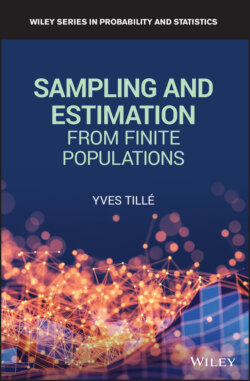Читать книгу Sampling and Estimation from Finite Populations - Yves Tille - Страница 13
1.2 Enumerative Statistics During the 19th Century
ОглавлениеIn the Middle Ages, several attempts to extrapolate partial data to an entire population can be found in Droesbeke et al. (1987). In 1783, in France, Pierre Simon de Laplace (see 1847) presented to the Academy of Sciences a method to determine the number of inhabitants from birth registers using a sample of regions. He proposed to calculate, from this sample of regions, the ratio of the number of inhabitants to the number of births and then to multiply it by the total number of births, which could be obtained with precision for the whole population. Laplace even suggested estimating “the error to be feared” by referring to the central limit theorem. In addition, he recommended the use of a ratio estimator using the total number of births as auxiliary information. Survey methodology as well as probabilistic tools were known before the 19th century. However, never during this period was there a consensus about their validity.
The development of statistics (etymologically, from German: analysis of data about the state) is inseparable from the emergence of modern states in the 19th century. One of the most outstanding personalities in the official statistics of the 19th century is the Belgian Adolphe Quételet (1796–1874). He knew of Laplace's method and maintained a correspondence with him. According to Stigler (1986, pp. 164–165), Quételet was initially attracted to the idea of using partial data. He even tried to apply Laplace's method to estimate the population of the Netherlands in 1824 (which Belgium was a part of until 1830). However, it seems that he then rallied to a note from Keverberg (1827) which severely criticized the use of partial data in the name of precision and accuracy:
In my opinion, there is only one way to arrive at an exact knowledge of the population and the elements of which it is composed: it is that of an actual and detailed enumeration; that is to say, the formation of nominative states of all the inhabitants, with indication of their age and occupation. Only by this mode of operation can reliable documents be obtained on the actual number of inhabitants of a country, and at the same time on the statistics of the ages of which the population is composed, and the branches of industry in which it finds the means of comfort and prosperity.1
In one of his letters to the Duke of Saxe‐Coburg Gotha, Quételet (1846, p. 293) also advocates for an exhaustive statement:
La Place had proposed to substitute for the census of a large country, such as France, some special censuses in selected departments where this kind of operation might have more chances of success, and then to carefully determine the ratio of the population either at birth or at death. By means of these ratios of the births and deaths of all the other departments, figures which can be ascertained with sufficient accuracy, it is then easy to determine the population of the whole kingdom. This way of operating is very expeditious, but it supposes an invariable ratio passing from one department to another. [] This indirect method must be avoided as much as possible, although it may be useful in some cases, where the administration would have to proceed quickly; it can also be used with advantage as a means of control.2
It is interesting to examine the argument used by Quételet (1846, p. 293) to justify his position.
To not obtain the faculty of verifying the documents that are collected is to fail in one of the principal rules of science. Statistics is valuable only by its accuracy; without this essential quality, it becomes null, dangerous even, since it leads to error.3
Again, accuracy is considered a basic principle of statistical science. Despite the existence of probabilistic tools and despite various applications of sampling techniques, the use of partial data was perceived as a dubious and unscientific method. Quételet had a great influence on the development of official statistics. He participated in the creation of a section for statistics within the British Association of the Advancement of Sciences in 1833 with Thomas Malthus and Charles Babbage (see Horvàth, 1974). One of its objectives was to harmonize the production of official statistics. He organized the International Congress of Statistics in Brussels in 1853. Quételet was well acquainted with the administrative systems of France, the United Kingdom, the Netherlands, and Belgium. He has probably contributed to the idea that the use of partial data is unscientific.
Some personalities, such as Malthus and Babbage in Great Britain, and Quételet in Belgium, contributed greatly to the development of statistical methodology. On the other hand, the establishment of a statistical apparatus was a necessity in the construction of modern states, and it is probably not a coincidence that these personalities come from the two countries most rapidly affected by the industrial revolution. At that time, the statistician's objective was mainly to make enumerations. The main concern was to inventory the resources of nations. In this context, the use of sampling was unanimously rejected as an inexact and fundamentally unscientific procedure. Throughout the 19th century, the discussions of statisticians focused on how to obtain reliable data and on the presentation, interpretation, and possibly modeling (adjustment) of these data.
